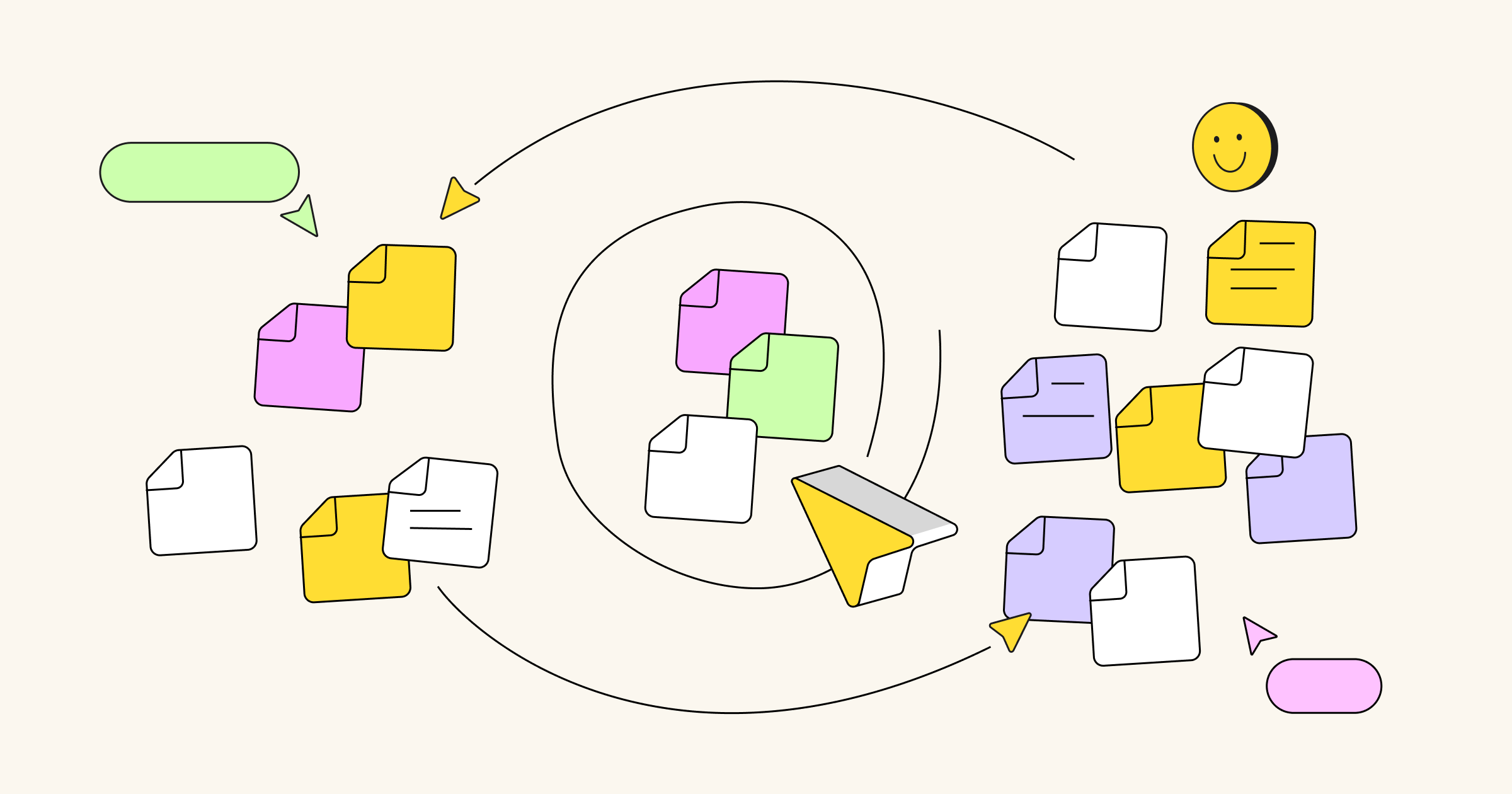You’ve probably heard the old sentiment about “too many cooks in the kitchen.” Or, maybe you’ve experienced it yourself.
Often, it can be true — too many hands working all at once can feel like chaos.
But here’s the thing: When you have a clear handle on who’s doing what, extra cooks can lead to peak efficiency and superior quality. Fortunately, a swimlane diagram can help you get a clear handle on everybody’s responsibilities.
What is a swimlane diagram?
A swimlane diagram is a flowchart that displays who is responsible for certain parts of a process. This visual tool takes something we’re all familiar with — the lanes of a swimming pool — and uses them to represent responsibilities within a team or an entire organization. Your diagram can either have vertical swimlanes or horizontal swimlanes.
Each person, department, or team gets their own “lane” on the diagram where their steps or deliverables will be listed. It makes it easy and intuitive to immediately understand who does what.
Swimlane diagrams have a long and storied history. They first started appearing in the 1940s as a variation on the flowchart diagrams that were being used at the time, such as multi-column charts. They were used, and are still used today, to sketch out business processes that involve more than one department within a company. In other words, they’re most commonly used to clarify roles and responsibilities within a multifaceted business.
The name ‘swimlane’ was devised by authors Geary Rummler and Alan Brache in their book ‘Improving Performance’ in 1990. Swimlane diagrams have many other names, such as Rummler-Brache diagrams and cross-functional diagrams.
Swimlane diagram example
A swimlane diagram will always follow a similar format initially but can change and grow depending on the complexity of the processes. There can be complex swimlane diagrams, particularly for established or cross-functional processes that have a lot of steps and team members involved.
But, for the sake of a basic understanding, let’s stick with a simple swimlane diagram example. This swimlane flowchart shows what happens immediately after a customer places an order. It outlines what happens after the order is placed and follows it through to one of the two final outcomes — cancellation or fulfillment.

This swimlane diagram demonstrates the business process involved in a simple sale situation. Each task on the diagram represents an important step in the process of making a sale, and each task will be allocated to a different department, depending on the role within the process. This diagram will help a business know where certain processes fail, who’s responsible for a failure, and which processes require optimization.
What is the purpose of a swimlane diagram?
A swimlane workflow diagram offers several important advantages for teams and organizations, including:
- Clarifying roles and responsibilities. One of the biggest benefits of a swimlane flowchart is that it clearly shows who’s doing what part of a process. It minimizes or even removes those frustrating, “Oh, I thought [other person] was doing that!” moments.
- Improves communication. Having an overview of all processes required in a task improves communication as it opens the door for structured discussions. There’s no doubt as to who is responsible for a specific task. This ensures everyone has a direct point of contact for any questions that arise or discussions that are required.
- Demystifying processes. The swimlane diagram itself is pretty simple, and that’s one of its greatest assets. It can break even the most complex processes down into an easy-to-understand flowchart. No complicated process maps or matrices — just an intuitive diagram.
- Uncovering bottlenecks and inefficiencies. Swimlane diagram requires you to break processes down by both teams and tasks. This can help you spot sticking points and bottlenecks that you can improve on.
- Improves analysis. The diagrams provide a detailed view of a business process, which makes analyzing each step easier. This means that errors can be spotted early on before they become time-consuming or costly to fix.
- Reduce redundancies. A swimlane diagram is beneficial for a business as it maps out the streamlining of a process within the company. After a process is complete, the diagram can be scrutinized to find out which roles and processes are unnecessary and unneeded for the completion of the task. Removing redundancies helps increase business efficiency.
- Helps businesses realize fundamentals. A swimlane diagram is helpful for businesses to understand how different the role players and technology used in the process relate and interact with one another. This can be helpful for businesses looking to improve business relations and understanding which departments need increased communication within the company.
How do you make a swimlane diagram?
A swimlane flowchart is helpful for boosting understanding about who’s handling what. But how do you create your own swimlane diagram? Here are five simple steps to follow.
1. Organize your basic information
Before you start plotting anything in your lanes, you first need to understand what information you’re working with. This means identifying:
- The process you’re mapping (e.g., order fulfillment)
- Who’s involved in that process (e.g., the customer, sales department, inventory department, and payments department)
- What tasks or steps are involved in the process (e.g., receiving the order, checking stock, etc.)
If you have this information jotted down before you create your diagram, you’ll have a much easier time mapping out your process.
2. Map out your lanes (or use a template)
Now that you understand what you need to plot, it’s time to create the skeleton of your diagram. It’s as simple as sketching as many lanes as you have teams or people. So, if there are four teams involved in the process, you’ll need four lanes.
Keep in mind that your lanes can run vertically or horizontally. You have the flexibility to choose what works best for you and your process.
Want to make this step even simpler? Grab our Swimlane Diagram Template so you can jump into the pool right away.


3. Find your starting point
It’s easiest to map things out on your swimlane diagram if you start at the beginning. Then you can move through the rest of the process in order.
So, figure out what the first step in your process is. In the case of the example we’ve been sticking with, the first step is a customer placing an order. That’s the first thing you’d list on your swimlane diagram, in the “lane” for the customer.
4. Move through the process
Once you have your starting point, it’s as simple as continuing through the rest of your process. Plot things in the appropriate “lanes” as you move through the various steps and tasks.
Keep in mind that this is a flowchart, so you’ll likely have a few questions to answer throughout the diagram. A couple of question examples from our running example include:
- Is the product in stock?
- Is the credit card valid?
Answering “yes” or “no” to those questions helps you determine what step of the process you move to next.
5. Review your diagram
That’s it — that’s all it takes to create a swimlane diagram. But, once you have the process mapped out, it’s smart to review it (ideally, with the team who handles the process). This gives you an opportunity to:
- Identify bottlenecks, inefficiencies, confusion, and redundancies
- Create a “future state” diagram that outlines your ideal process
This review process will ensure that you use your swimlane diagram as a point of reference and as a tool that helps you and your organization work more effectively.
Swimlane diagram standard symbols
A few symbols are widely accepted as the universal symbols for swimlane diagrams. Using these symbols helps ensure that anyone looking at your diagram can quickly and easily decipher the information being presented.
The symbols you use in a swimlane diagram are the same as the standard flowchart symbols. These symbols are:
- Rounded rectangles represent the start and end of the diagram.
- Rectangles are the go-to symbol in any flowchart which represents a process or the completion of a task. For example, the rectangles in the diagram above represent different jobs that must be completed for the chart to progress.
- Arrows represent the movement between different processes.
- Diamonds represent a question or the point at which a decision needs to be made.
- Parallelograms represent an input or output. This includes any information that enters or is produced from the process flow.
Swimlane diagrams vs. flowcharts
The basic presentation of a swimlane diagram looks very similar to a standard flowchart. Both often use the same symbols and templates. But there’s a key difference.
Flowcharts are most often used to map out a single process. Swimlane diagrams are more focused on different team members and their roles in the process. Swimlane diagrams map out who needs to do what for success. Swimlanes are also more useful for businesses that want to map out the sub-processes within a larger process.


Swimlane diagrams originated from standard flowcharts. But as businesses became more complex and started using more moving parts to complete a process, a more all-inclusive and holistic diagram was needed.
Swimlane diagrams best practices
Keep these tips in mind when creating your swimlane diagram:
Don’t overload the diagram with text
An effective swimlane diagram requires a balance between the amount of text used and the amount of information relayed. In the end, the diagram shouldn’t be overloaded with text and paragraphs. But it should still accurately map out the desired process.
Have a clearly defined process
A swimlane diagram cannot be properly mapped out if the process is not clearly defined. For example, businesses cannot determine which roles will be involved in a simple sale if the simple sale process isn’t clearly defined at the beginning.
Ensure the right people have access to the diagram
The objective of a swimlane diagram is to map out the sub-processes and the roles and responsibilities of the people involved in those sub-processes. Therefore, it’s essential that all the people necessary for the process to be complete have access to the diagram to know their jobs within the greater scheme.
Use a template
Knowing how to create a successful swimlane from scratch is not always an easy task. For companies who have never used a swimlane before or who simply want to save time, we highly recommend using our customizable Swimlane Diagram Template.
Know who’s doing what with a swimlane diagram
To do great work, you need teams to work like well-oiled machines. Yet, confusion about who’s responsible for what is common. Only about half of employees strongly agree that they know what’s expected of them at work.
That’s where a swimlane diagram can help. It provides instant clarity about who’s handling each part of a process so people can stay in their lanes and get across the finish line faster (not to mention with less stress).
To see the potential visualization power of swimlane diagrams, have a look at this Swim Lane Diagram with Data example from the Miroverse.




